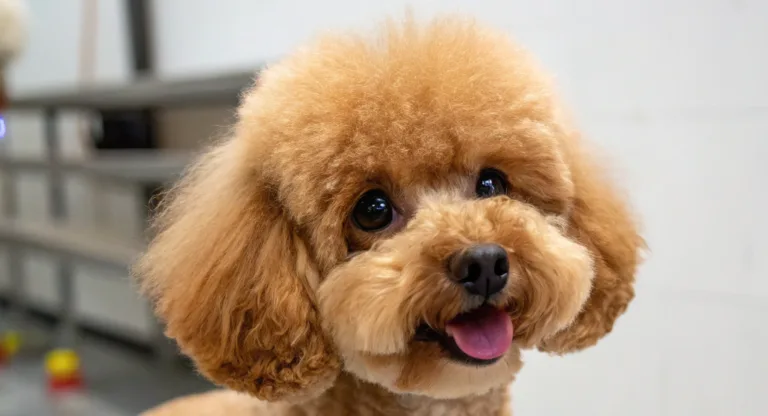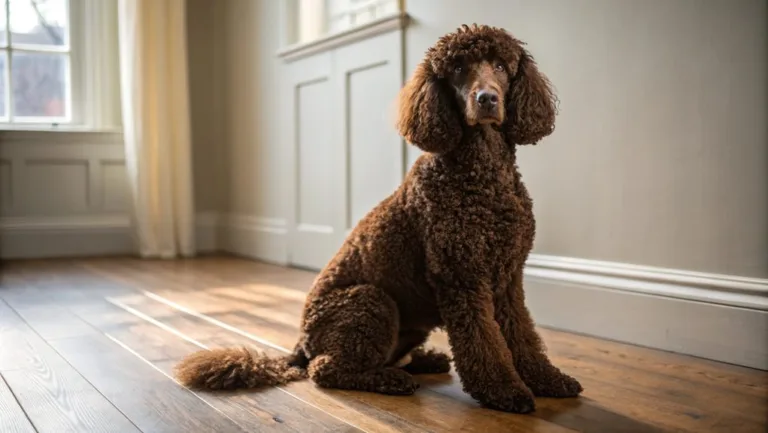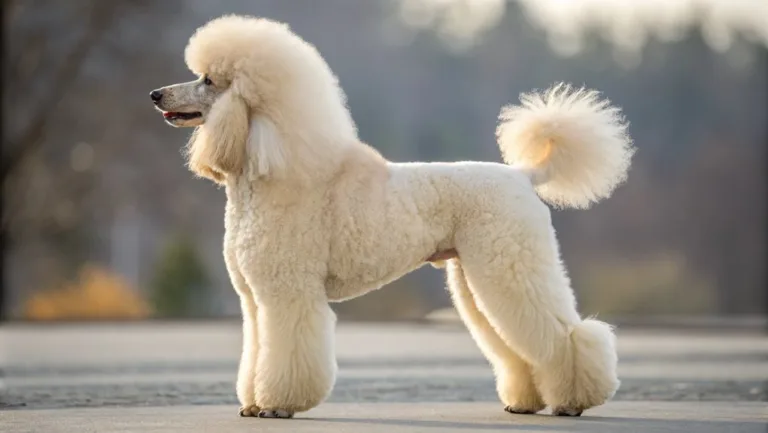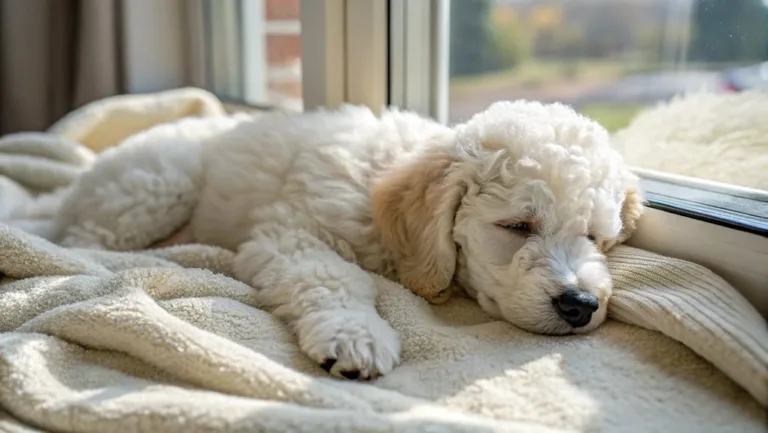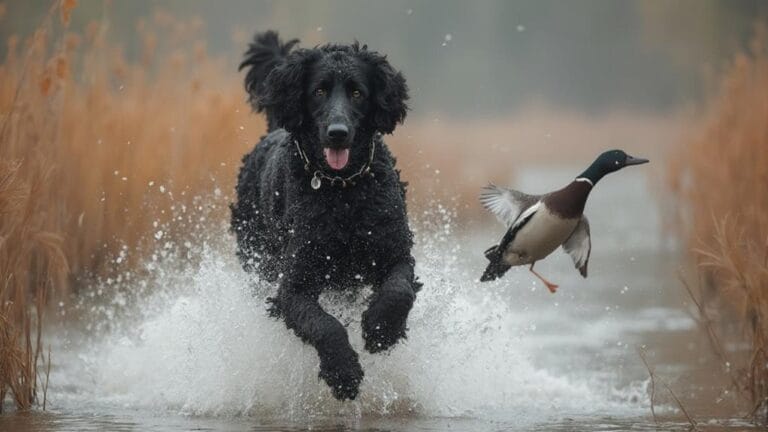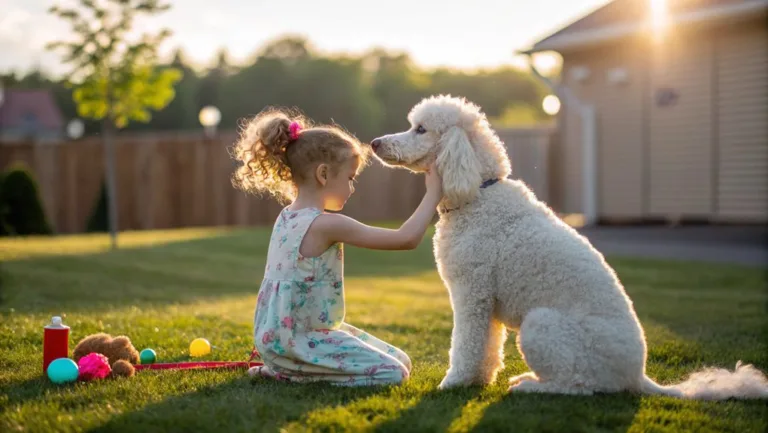Rarest Poodle Color: A Guide to Extraordinary Coat Colors
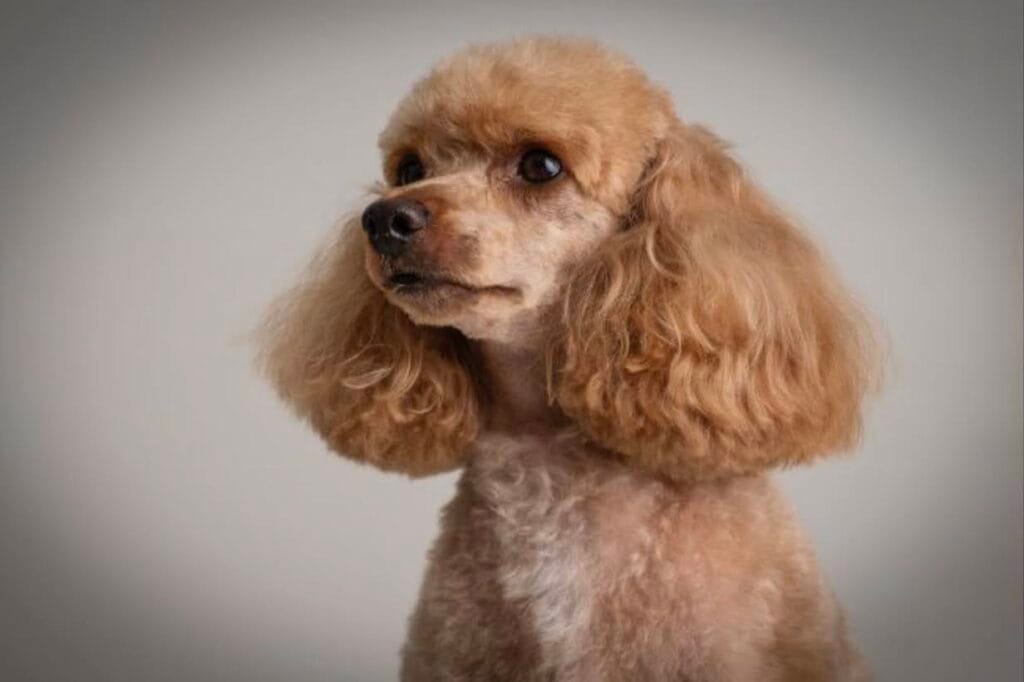
When exploring the rarest Poodle color, you’ll discover that the apricot stands as nature’s rarest masterpiece in the breed, created through an intricate dance of genetics and selective breeding.
The warm, peachy hue emerges from complex genetic interactions, transforming dramatically as puppies mature through distinct phases over their first two years. You’ll notice how this elusive shade requires careful maintenance, with regular grooming and protection from sun exposure to preserve its distinctive glow.
While breeding these elegant dogs demands extensive genetic knowledge and patience, their unique beauty captures the imagination, revealing deeper mysteries about canine color inheritance that continue to fascinate enthusiasts and breeders alike.
Key Takeaways
- Apricot is recognized as the rarest Poodle color, requiring specific genetic combinations and careful breeding practices to produce.
- Breeding apricot Poodles demands extensive genetic knowledge due to recessive genes influencing coat color inheritance patterns.
- Color stability challenges exist as apricot coats may fade over time, requiring dedicated maintenance and protection from sun exposure.
- Historical breeders like Mrs. Tyndall and Miss Brunker faced significant challenges in establishing and maintaining apricot bloodlines.
- Modern breeding emphasizes both color preservation and health testing to maintain the distinctive apricot hue while ensuring genetic health.
The Apricot Poodle Legacy

Tracing the legacy of apricot Poodles reveals why they’re considered the rarest Poodle color. When you look into their history, you’ll find dedicated breeders like Mrs. Tyndall and Miss Brunker, who faced countless challenges in their quest to perfect these ethereal creatures, including devastating losses to diseases like distemper.
The genetic complexity behind these rare colors is fascinating, as apricot Poodles carry unique genes that often lead to color fading, especially in bloodlines with white or silver ancestry.
You’ll notice how modern breeding strategies have evolved, with careful attention paid to selecting partners that won’t dilute the precious apricot hue. When you’re exploring apricot Poodle lineages, you’ll discover the profound impact of breeders like Hilda Meisenzahl, who focused on strengthening existing strains rather than creating new ones.
Today’s apricot Poodle legacy continues through conscientious breeders who prioritize health testing alongside color preservation.
As you investigate deeper into their world, you’ll understand why maintaining this delicate balance of beauty and health makes these dogs truly exceptional, preserving their status as living artwork within the Poodle breed.
Understanding Poodle Color Genetics
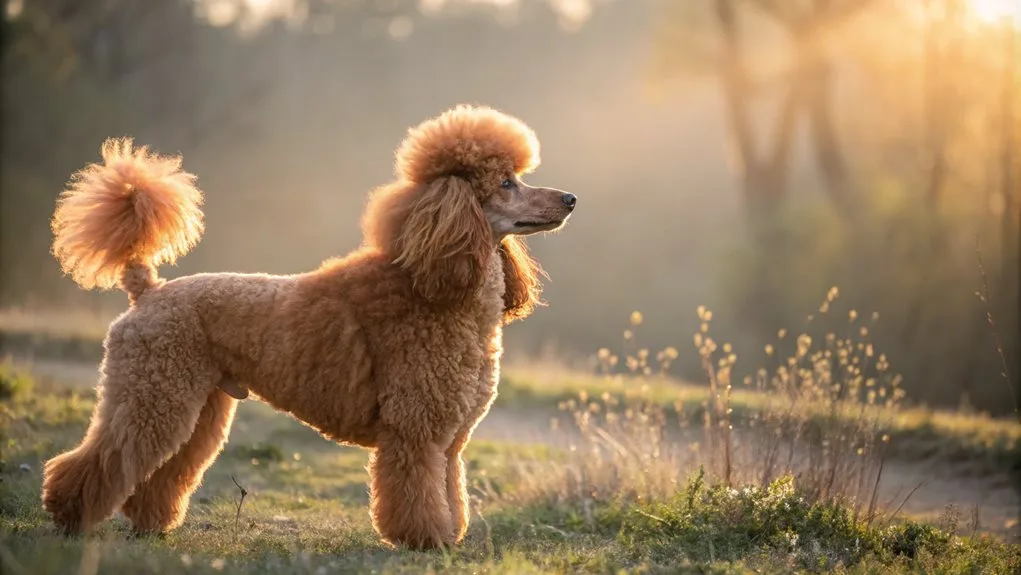
Peering into the world of Poodle color genetics reveals an intricate dance of genes and alleles that determines each dog’s unique coat color.
You’ll find that within this complex genetic tapestry, the interplay between dominance and recessiveness shapes every shade and pattern you see in the poodle breed.
When you explore deeper, you’ll discover how the A locus influences pigment distribution, creating everything from rich reds to mysterious phantom poodles with their distinctive markings.
The B locus orchestrates the appearance of blacks and browns, while the E locus conducts the symphony of rare poodle colors like apricot and cream.
Most fascinating is how a poodle’s genotype, hidden beneath the surface, manifests in their visible phenotype – a demonstration of nature’s artistic precision.
Perhaps most intriguing are the parti poodles, whose stunning two-toned coats result from specific genetic combinations, reminding us that even the rarest color patterns follow predictable inheritance patterns.
Through understanding color genetics, you’ll appreciate how each poodle’s unique appearance is a carefully coded masterpiece, written in the language of DNA.
Color Transformation Over Time
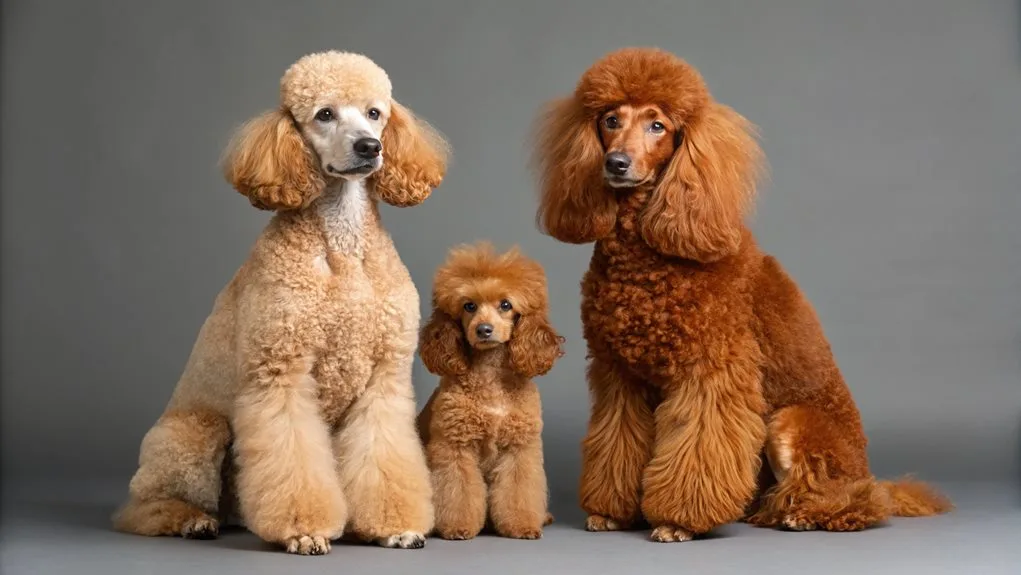
Three distinct phases mark a Poodle’s dramatic color transformation journey.
You’ll first notice changes around 2-3 months of age, when your puppy’s coat begins its initial shift, especially in rare colors like blue and silver.
The second phase occurs between 6-18 months, when the fading gene becomes most active, creating striking transformations that can leave you amazed at your pet’s evolving appearance.
The final phase extends through your Poodle’s second year, when progressive graying may continue to alter their appearance.
You’ll witness how sable poodles lose their distinctive black-tipped fur, while a blue poodle’s coat settles into its permanent shade.
These changes, recognized within the poodle breed standard, create a fascinating display of colors and patterns that unfold like nature’s own artwork.
Understanding your Poodle’s color journey helps you appreciate these natural changes.
While some coats remain relatively stable, others undergo remarkable metamorphoses, particularly around the ears and guard hairs, where original colors often persist longest, creating beautiful contrasts that make each Poodle uniquely special.
Breeding Rare Poodle Colors
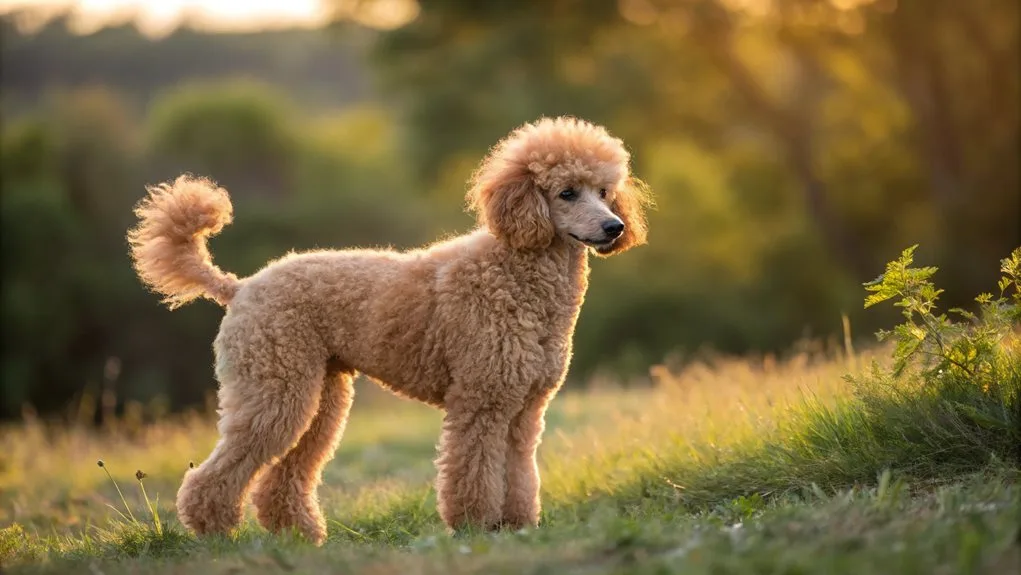
Breeding rare-colored Poodles calls for extensive knowledge of genetics and meticulous parent selection. You’ll need to understand how recessive genes influence coat colors and how these traits pass from generation to generation, particularly when working with sought-after varieties like silver poodles and apricot poodles.
When you’re breeding for rare colors, you’ll discover that color stability presents a unique challenge, as many coveted shades tend to fade or transform over time. Red poodles, born with rich mahogany coats, often lighten as they age, while silver poodles emerge black before gradually revealing their true color.
Your breeding strategies must account for these natural transformations, carefully selecting parents whose colors have remained stable through maturity.
Working with parti poodles adds another layer of complexity, as the piebald gene creates stunning patterns that require precise genetic combinations. You’ll need to maintain genetic diversity in your breeding program while still pursuing these rare colors, balancing the desire for specific traits against the broader health and well-being of the bloodline.
This delicate dance of genetics and selection helps preserve these extraordinary color variations for future generations.
Health and Color Connection
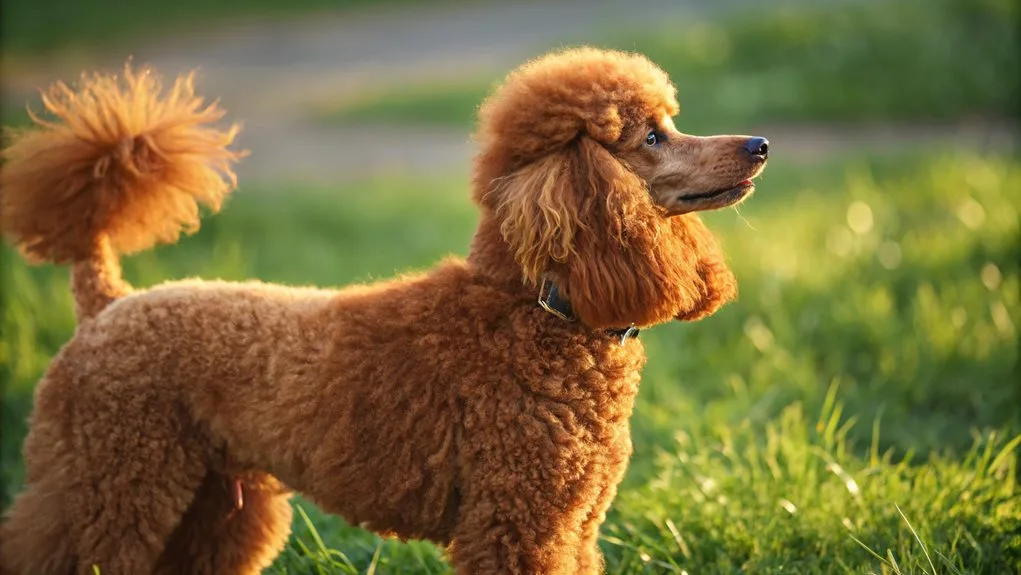
Coat color in poodles does more than determine appearance – it can signal potential health concerns that owners should watch for. When you’re choosing your poodle companion, understanding these health implications of coat color could help you provide better care throughout tyourlife.
White poodles, with their pristine coats that shimmer like fresh snow, face a higher risk of congenital deafness, while their darker-coated cousins are more susceptible to skin cancer in dark-colored poodles, particularly in their paw pads.
The genetic basis of coat color is fascinatingly complex, with multiple genes working together like an intricate dance of nature. You’ll notice the fading gene‘s influence as some poodles’ coats transform over time, shifting from deep blacks to silvery blues or rich browns to café au lait.
When it comes to breeding considerations, it’s essential to look beyond just aesthetics. While poodles of all colors share similar traits and temperaments, certain color combinations can affect both health and appearance.
Kennel Club Color Range Recognition
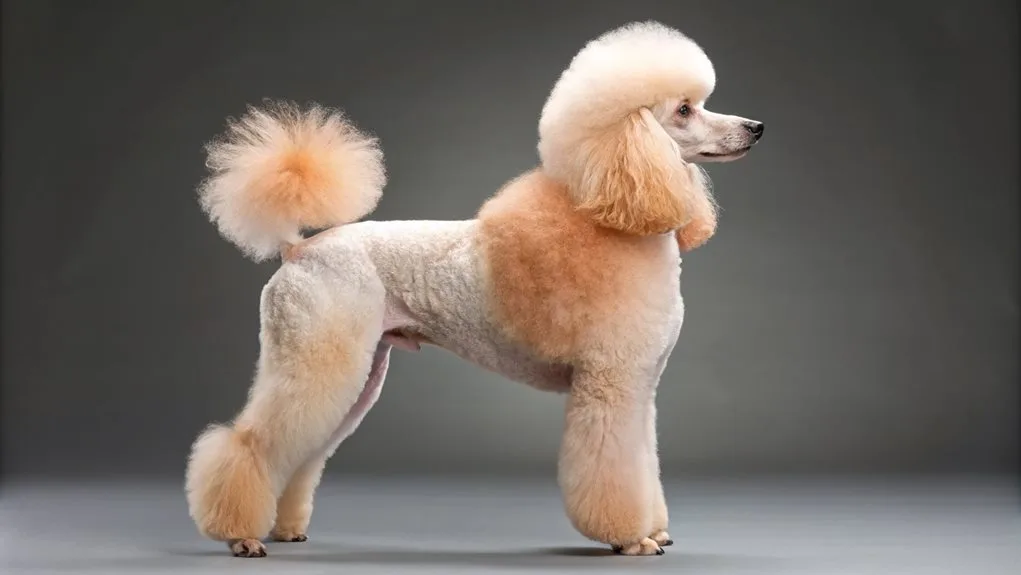
Major kennel clubs worldwide have distinct standards for recognizing Poodle colors, with each organization maintaining its own specific criteria for show competitions.
For poodle owners seeking to compete, understanding these standards becomes essential, particularly when dealing with color variation in their poodle’s coat.
The American Kennel Club, for instance, only permits solid color Poodles in conformation classes, while the United Kennel Club embraces a broader spectrum including parti poodles.
You’ll find that breed standards vary markedly between organizations, reflecting different cultural and historical perspectives on what constitutes the “ideal” Poodle. While the AKC recognizes eleven solid colors, from the common black to the rarest apricot, the FCI in Europe maintains slightly different criteria.
What’s fascinating is how these standards have evolved, shaping the way breeders selectively pair dogs to achieve specific colorations. When you’re exploring these regulations, you’ll notice that some of the most striking patterns, like the eye-catching parti-colored coats, aren’t eligible for certain shows despite their historical significance to the breed’s heritage.
Caring Apricot Coats for the Rarest Poodle Color
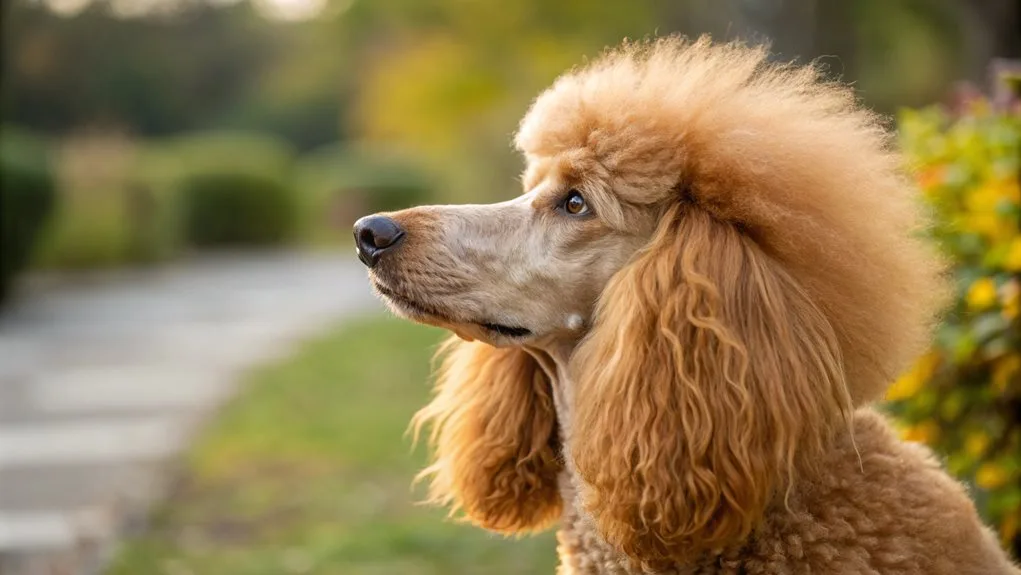
While grooming any Poodle requires dedication, maintaining an apricot coat the rarest poodle color demands particular attention due to its unique color characteristics.
You’ll need to embrace a consistent daily brushing routine, using proper techniques to prevent matting while preserving your Poodle’s distinctive apricot hue.
Professional grooming should become a regular part of your care schedule, typically every 4-6 weeks, to maintain both the coat’s health and its vibrant color.
When bathing your Poodle, you’ll want to use color-enhancing shampoos specifically designed for apricot coats, followed by thorough drying to prevent moisture-related skin issues that can develop in their dense fur.
Your grooming toolkit should include high-quality coat care products, including specialized conditioners that’ll keep the hair soft and manageable.
While focusing on aesthetic maintenance, don’t overlook important health considerations – regular ear cleaning, eye care, and skin checks should accompany your grooming sessions.
The apricot coat color may gradually fade with time and sun exposure, but with proper care and protection, you can help maintain its warm, distinctive glow for years to come.
Color Testing and Verification
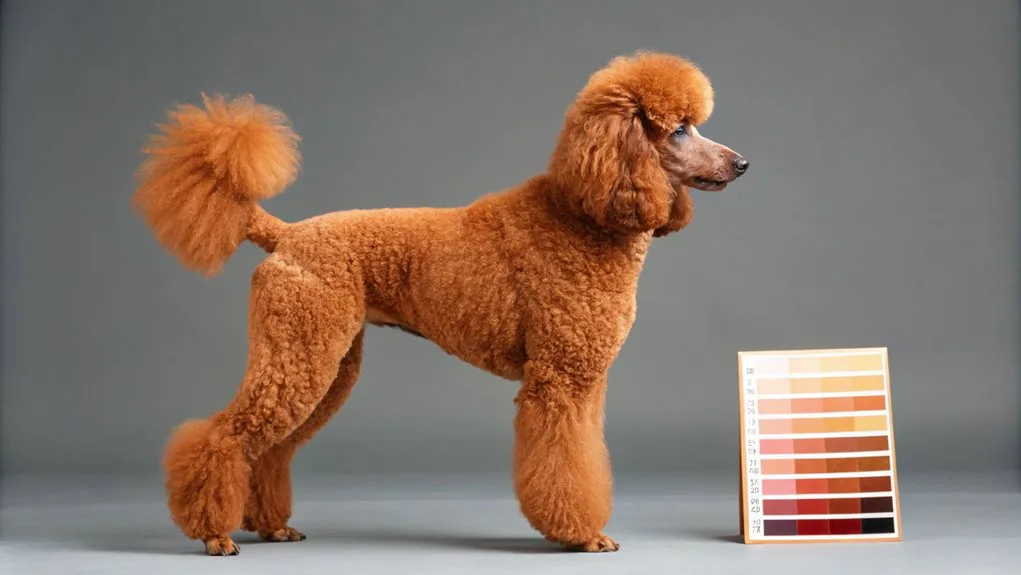
Understanding your Poodle’s true color requires genetic testing of five essential loci: A-locus (Agouti), B-locus (Brown), D-locus (Dilution), E-locus (Extension), and K-locus (Dominant Black). Through thorough genetic testing, you’ll reveal the secrets behind your Poodle’s unique coat color, discovering whether they carry genes for dilution, fading, or rare color combinations.
- The A-Locus test reveals if your Poodle carries genes for red, fawn, or sable coloring.
- D-Locus testing identifies dilution factors that can transform black to blue or brown to silver beige.
- E-Locus results help predict whether puppies might inherit apricot or cream coats.
- K-Locus testing determines if your Poodle carries the dominant black gene.
When you’re planning to breed, color selection becomes a delicate dance of genetics, where understanding coat color genetics helps you make informed decisions.
The intricate interplay between these genetic markers shapes your Poodle’s final appearance, much like an artist mixing colors on a palette.
Through careful poodle breeding and strategic genetic testing, you’ll navigate the complex world of color inheritance, ensuring the preservation of both rare and beloved coat colors for generations to come.
Conclusion
As you’ve journeyed through the fascinating world of apricot Poodles, you’ll appreciate how this rare color represents more than just a beautiful coat variation.
You’re now part of a legacy that stretches back to Sowden Yellow Gall in 1898, understanding the complex genetics, careful breeding practices, and unique care requirements that make these dogs so special. When you look at an apricot Poodle today, you’re witnessing living history in the breed’s evolution.
FAQ: Rarest Poodle Color
In the world of poodle, some of the rarest color poodle variations include merle poodles, apricot, tuxedo poodle, and unique combinations like parti poodle. These poodle variations are not as commonly seen as the more common colors such as black, white.
The blue poodle is considered rare because it is not a true blue, but rather a diluted black coat. The final color appears over time as the poodle was born black and gradually changes due to a genetic color change process.
Poodles may experience a color change as they mature. This is often due to genetic factors, where a poodle named with a specific solid base color may lighten or change shades over time, leading to unique poodle variations.
A parti poodle is a poodle with a white base color and patches of another color. This pattern is rare because it requires specific genetic combinations, and while it is recognized by some breed standards, it is less common in show rings.
Red and apricot poodle puppies are rare compared to black poodles or cream poodle. These colors require a specific gene that is less prevalent in the breeding population, making them highly sought after.
The rarity of a specific color in poodles does not inherently affect poodle health. However, breeding for rare colors without considering genetics and health can lead to several potential health issues.
When breeders focus primarily on producing rare colors, they might inadvertently overlook important genetic factors that contribute to the overall health and well-being of the dogs.

